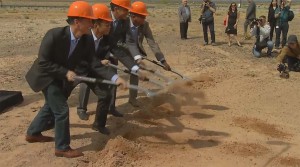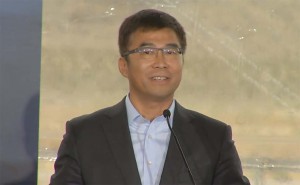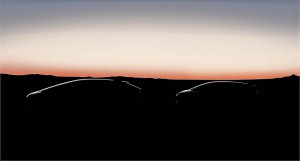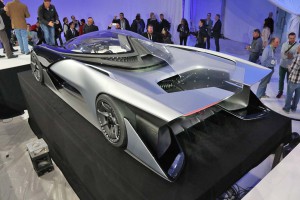The Chinese-backed battery-car start-up Faraday Future has broken ground for a $1 billion assembly plant set to rise in the Las Vegas suburbs.
The factory, which will eventually employ 4,500, is expected to produce a series of new electric vehicles, though the California-based company has provided only a faint glimmer of what it has in store once production begins in 2018.
“Our aim is to complete a program that would normally take four years and do it in half the time, while still doing it right,” Dag Reckhorn, the head of global manufacturing for Faraday Future, said during a groundbreaking ceremony on a desert field in the Sin City suburb of North Las Vegas.
Operating in near-complete secrecy, Faraday Future burst onto the scene in January, revealing a high-tech sports car concept during a ceremony at the annual Consumer Electronics Show. Even then, officials with the start-up declined to reveal much about their plans, confirming only that they would launch production with a somewhat more conservative vehicle.
(For more on the CES debut of Faraday Future, Click Here.)
A teaser image Faraday has since released suggests its first product will likely be a futuristic-looking sedan. The company has adopted a vehicle architecture quite different from that of conventional, gas-powered cars. More in line with the approach taken by rival Tesla Motors, with most of the drivetrain components – including the batteries — located beneath the passengers, rather than in front of them.
That layout will permit a much larger interior, suggested by the almost bubble-like appearance of the two vehicles in the teaser image, more in line with a sci-fi film than what’s on the road today.
“We plan to bring the future forward,” said Reckhorn, during his presentation at the groundbreaking ceremony.
Beyond the use of an electronic drivetrain, Faraday is believed to be pushing into autonomous driving and has strongly suggested it will offer an extensive array of infotainment and other connected car features once its first car rolls out.
(For a look at the new Tesla Model 3, Click Here.)
That’s in keeping with the strategy of Jia Yueting, the Chinese entrepreneur often referred to as that country’s Steve Jobs, and a major investor in the Faraday Future project. He is expected to try to integrate some of his company’s Internet services into the new electric cars, though precise details have not been disclosed.
Indeed, Faraday remains only slightly less of a mystery than it did before its debut at the 2016 CES. Ding Lei, who heads the auto division of Chinese-based LeEco and serves as acting CEO of Faraday, suggested only that the goal of the new carmaker is to develop “disruptive innovation(s).”
The new Las Vegas plant itself will be “highly connected and environmentally friendly,” promised Reckhorn. It will feature glass windows, Faraday officials noted, and make use of renewable energy, where possible – not in itself a difficult claim considering much of the power for the Las Vegas electric grid comes from the nearby Hoover Dam. But Reckhorn also suggested Faraday will “invites consumers to be part of the process,” which might mean providing buyers to watch their vehicle being built online.
Faraday is the second high-tech automaker to invest in the State of Nevada in recent times, Tesla currently ramping up production of its massive Gigafactory battery plant near the other gambling mecca of Reno.
Though Faraday didn’t get quite as large a state incentive package, Nevada has still pledged to invest $335 million to support the plant – including $215 million in tax breaks and another $120 million in infrastructure improvements. In turn, Faraday plans to put up a $75 million bond to back various road, rail and water projects for the 900-acre site.
Located about 15 miles from the neon-lit Strip, Faraday is hoping to turn the factory into a tourist attraction, as well as a production site, Reckhorn adding his hope that visitors will then be inspired to buy one of Faraday’s vehicles.
(Google on a hiring spree for its autonomous vehicle program. Click Here for more.)
How many it will be able to produce is unclear. The $1 billion figure is in line with what conventional automakers have been spending on all-new assembly plants in recent years, facilities producing upwards of 200,000 vehicles annually. It is likely to include not only a conventional assembly line but operations dedicated to producing some key parts and components, industry observers suggest. Otherwise, it would be hard to explain plans to hire 4,500 employees.
These days, traditional car plants producing 250,000 to 300,000 vehicles a year can get by on less than half that workforce.
For its part, Tesla is currently building its Model S and Model X battery cars at a plant in Fremont, California that used to be operated as a General Motors-Toyota joint venture. Production is expected to near 90,000 this year, then rise to as much as 400,000 later this decade with the addition of the more mainstream Model 3 Tesla unveiled late last month.






That’s nice the factory will use glass windows versus windows made of other materials…J/K.